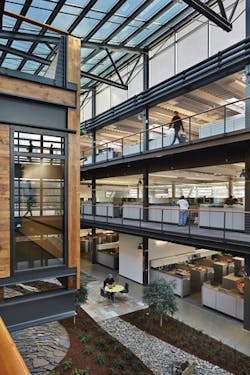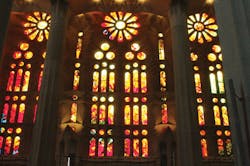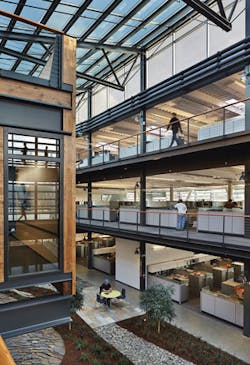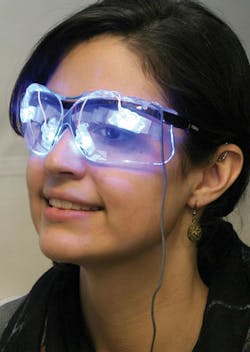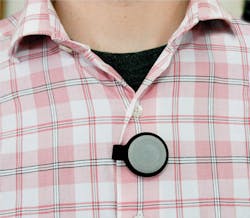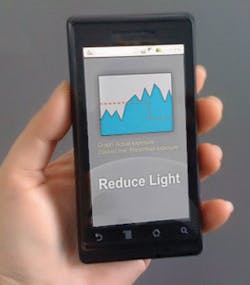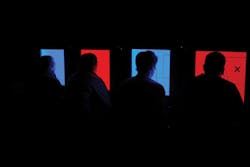The HCL concept is as old as humankind's place under the Sun. But putting it into practice via tunable LED lighting will be a challenge. Some people are already trying, as MARK HALPER discovers.
You might not have yet heard the phrase "human-centric lighting" (HCL). But it's one of the oldest concepts under the Sun. Ever since humankind first yawned and stretched at dawn, and lay down to sleep at night, a 24-hour pattern of natural light that changes throughout the day and gives way to darkness has paced and conditioned our movements. Some 2.5 million years of the genus Homo's wakefulness under the blue-enriched wavelengths of daytime, and of tiredness in the reds and ambers of dusk, have conditioned the human circadian rhythm so that blues stimulate; reds, ambers, and darkness relax.
Yet in 120 or so years of artificial, electric lighting, manufacturers of lamps and luminaires have paid little attention to its color. The industry has existed for one main function: to illuminate. It has given little thought to how it might alter patterns of illumination and change wavelengths and colors to suit humans' daily cycle. While architects have paid homage (Fig. 1), the lighting industry has largely ignored it. But that is all beginning to change.
As we reported in our last issue, scientific studies over the last 20 years have proven that light's spectral content and its intensity do indeed impact the human circadian rhythm. Blue-enriched white light, for instance, can play both a villainous and a virtuous role. Too much blue at night can undermine sleep, because blue frequencies suppress the sleep-inducing hormone melatonin.
Learn more about human-centric lighting and how light promotes health and productivity at the 2017 Lighting for Health and Wellbeing conference July 27 in Newport Beach, CA:lightingforhealthandwellbeing.com
Those same blue frequencies, however, play a stimulating role during the daytime - when we tend to need it - because they excite a pigment called melanopsin that resides in the eye's non-visual photoreceptors and send signals to the brain where they stir up the body's master clock, as discovered in the early 1990s by Oxford University neuroscientist Russell Foster and others. That clock controls a number of physiological clocks including the circadian one. The non-visual photoreceptors are called the intrinsically photosensitive retinal ganglion cells, or ipRGCs; the master clock is called the suprachiasmatic nucleus, or SCN.
This new knowledge comes along at a perfect technological juncture, as the modern emergence of LED lighting with its solid-state, digital nature opens the possibility of tuning light wavelengths and intensity to facilitate human performance - to induce alertness and restfulness when we need it, and even to correct the health hazards inherent in the blueish LED-lit gadgets, lamps, and streetlights that critics say can wreck our sleep and cause other bodily harm.
The potential to put LED lighting to use in such a manner is far greater than any other artificial light source has allowed.
FIG. 1. Catalan architect Antoni Gaudí appreciated the relationship between the light spectrum and humans' daily cycles when he designed his still unfinished masterpiece, Barcelona's La Sagrada Família, beginning in 1883. The cathedral's east-facing windows emphasize the blues of daytime (top). The west-facing windows feature the ambers, reds, and oranges of sunset (bottom). The lighting industry is beginning to pay more attention to the same thing. (Source: Mark Halper.)
"The LED allows us to be a little bit more precise than incandescent because you can tune the spectrum," noted Mariana Figueiro, acting director of Rensselaer Polytechnic Institute's Lighting Research Center (LRC). "You can change the spectrum over the course of the day. You can achieve these things with other light sources. But obviously with LEDs it's easy because you can tune and change; you can pick what you want. So the flexibility of the LEDs is a must, there's no question about it."
Or as noted by Rensselaer's Bob Karlicek, the director of LRC's rival research group called the Center for Lighting Enabled Systems and Applications (LESA), "With LED lighting, we now have the ability to turn the full complement of knobs in intensity, in color, and in spectral power distribution."
But it's one thing to identify cause and effect in the scientific laboratory. It's another to engineer those findings into products and services that yield tangible results in real-world scenarios.
In our last LEDs Magazine feature, we noted that the healthcare industry is pioneering many of the applications of HCL, also known as circadian lighting. Hospitals such as the Aarhus University Hospital in Denmark; St. Augustinus Memory Center in Neuss, Germany; and St. Mary's Hospital in London are tuning white light to different levels of blues and reds and other colors to facilitate better rest and alertness and to thus aid the healing process among dementia sufferers, brain trauma patients, and others. Schools such as Miami-Dade County Public Schools in Florida and Mobile County Public Schools in Alabama are also beginning to work with circadian lighting.
But could the same principles apply in the workplace? Could specially tuned lighting that changes throughout the day and night make workers more alert, more engaged, happier? Could it improve their morale? Could the same principles apply at home? Could individuals tailor lighting schemes specifically tuned to their own idiosyncratic requirements?
More and more experts believe that the answer to those questions might indeed be a big, general yes.
Circadian office trials
In one broad, ongoing field test, Figueiro and the LRC have been working for about three years with the US Government's General Services Administration (GSA) to determine the effect of different lighting patterns on workers at five different GSA buildings across the country - two in Washington, DC, and one each in Seattle, WA (Fig. 2); Portland, OR; and Grand Junction, CO. They are also now adding two more GSA sites - another in DC and one in White River Junction, VT.
The LRC work at GSA focuses largely on "ways to deliver circadian light to people while they're at work during the day," said Figueiro. "It could be as simple now as your cubicle partition becomes an illuminated partition and it changes the lighting based on what you want. It could be a light table. It could be goggles (Fig. 3), a computer screen, a table lamp. There are different ways to deliver light that is not just your ceiling light. That's the beauty of LEDs - they allow you to think outside the box. You don't just think about ceiling lights anymore. You start thinking of very different ways of delivering the tunable light."
FIG. 2. It's difficult to tease out the exact effect of light in an office setting, but that's not stopping Rensselaer Polytechnic's Lighting Research Center (LRC) from trying. It's studying light in the workplace at several General Services Administration buildings, such as at this GSA facility in Seattle, designed by ZGF Architects. (Source: ZGF Architects.)
The LRC has even developed a wearable device called a daysimeter that measures the amount of light a person receives during the day and, via a combination of apps, a hub, and connected smart lights, automatically rebalances the color temperature of room lights to maintain the person's circadian health, as our sister publication Lux Review wrote last year (Fig. 4; http://bit.ly/2ccZqfn).
While the LRC has yet to reach final conclusions on the human circadian effect of different light patterns at the GSA facilities, it has determined preliminary findings.
"One of the things we're learning is everybody's being exposed to very little light," said Figueiro. "We talk a lot about too much light at night, but the truth is we may be getting too little light during the day, and that may be the main issue of all the negative effects of the built environment on health and wellbeing. Part of what we're doing is we're establishing a minimum amount of circadian stimulus that people need to be exposed to in federal buildings."
Figueiro and her team are continuing to look into the consequences of too little light, and at the possible benefits of properly tuned and specific amounts of circadian lighting. Having already observed some 200 GSA office workers with more to come, they are investigating whether tunable lighting can indeed support circadian entrainment, which is a measure of how strongly the body clock is tuned to natural day/night patterns.
Early insights
"I'm still doing the data analysis, so I don't want to overstate any of these results, but we're seeing a relationship between how much light you get during the day and how well you sleep, how your mood is, how stressed you are," Figueiro noted. "The more light you get during the day, the more entrained a person is. We look at the relationship between light, dark, rest, and activity patterns. You tend to be both more awake and to sleep better when there's more circadian light. People are saying they're sleeping better when they have more light during the day in the built environment."
One reason that Figueiro is still deliberating over the causes and effects at the GSA facilities is that, as she allowed, "When you do these field studies, teasing out the effect of light is very hard."
FIG. 3. One way to administer different light frequencies is through the use of goggles. (Source: Lighting Research Center.)
Whereas in hospitals - the setting for many of the early HCL implementations - patients are in controlled environments that typically already monitor many of their biometric functions and thus make it easier to infer the effect of light, workplaces are prone to many variables and other factors that impede reliable lighting studies. Those factors include all of the workplace's myriad physical and psychological elements, as well as the many individual factors in one's personal life and psyche that affect their mood, morale, performance, and the like.
"Moving into the workforce, it's really hard to do these studies," noted Karlicek at Rensselaer's LESA. "We're kind of in this interesting Catch-22 where we have enough anecdotal information from studies that have been done going back to the early 1900s on how artificial light impacts human beings. Light does have an impact on cognition, it does have an impact on alertness, it does have an impact on wellbeing - we don't have the expression 'mood lighting' for nothing - but we don't really have what I would call a full evidenced-based understanding of how lighting's full spectral power distribution can really impact human performance. What we don't really have are very well-defined studies that allow us to have a prescriptive lighting recipe for light and human-centric lighting,"
Call in the engineers
Karlicek and the engineering-oriented LESA are out to change that. LESA is developing eyewear, including a tiny pea-sized spectrometer, that measures the amount of different frequencies of lights that enter the eye. Wearers will link the spectacles wirelessly into a smartphone app that will then send data off to the cloud for analysis. The concept is similar to the daysimeter that the LRC first developed in 2005, but the design is different.
LESA hopes to leapfrog the LRC technology. With the spectrometer, it wants to measure light spectrum within 5-10-nm bands. It would also measure light that actually enters the eye, rather than the general surrounding light. LESA believes that such a device and system would represent a big breakthrough in accurately pinpointing and delineating the amount of different color and intensity of light an individual receives, although LRC says that it already provides those features.
"The one thing that's always been missing is the spectrally resolved light dose throughout the day," Karlicek said. "This is one of the things that's really needed to start taking a look at answering questions like 'How much light is really bad, what is the intensity, what light dose are you really getting, and what colors of light are you getting throughout the day? Are you staring at your monitor? Are you watching television in a dark room at night? Are you working in a brightly lit environment?' We want to take it to the next level and really involve spectrum, so that we can really answer questions like 'This was your blue light dose, versus your turquoise dose versus your cyan dose versus your yellow dose, and so on.'"
In addition to spectral distribution, the system will also take certain biometric readings including heart rate, facial temperature, and motion (actigraphy) that when combined and analyzed in the cloud will, according to Karlicek, ascertain a person's circadian state in a manner that today requires more tedious techniques such as blood or saliva samples.
"What we want to be able to do is take a look at how we process all of this noisy data including light dose data and heart rate data and actigraphy motion data, to try to extract an accurate circadian phase, using surrogates - obviously we're not going to be doing saliva testing, and we're not going to be drawing blood samples," said Karlicek. LESA has a patent pending on the signal analytics technology.
When LEDs Magazine spoke with Karlicek, he was awaiting delivery of the spectrometer from South Korea, and was hoping to have built trial units of the eyewear system by the end of this year.
The group's partners on the device include the Illuminating Engineering Society (IES), as well as George "Bud" Brainard, the director of the Light Research Program at Thomas Jefferson University in Philadelphia who is one of the developers of a circadian lighting system for astronauts on the International Space Station.
Once LESA builds and debugs its prototypes, its hopes to then begin field trials through its corporate members such as Stoneham, MA-based Circadian, a technology and consulting company that specializes in helping to optimize round-the-clock operations.
Changing the clocks
The system could eventually help individuals understand their own circadian response to light - which varies for every individual. LESA's John Wen, a Rensselaer professor of electrical engineering, noted that it could then help individuals apply their own light treatment to help them rebalance their circadian rhythm in relation to, say, shift work or travel. Today, it takes an average human about 8 days to readjust after a 12-hour flip in their routine (for example, if they have traveled halfway around the world, or if their shift work changes from an 8 a.m. start to 8 p.m.).
A personalized treatment, based on the analysis of individual light intake and biometric effects, could expedite the adjustment - especially if combined with adjustments to other variables, such as room temperature and sleep homeostasis, which is a non-circadian sleep determinant that is essentially a measurement of one's inclination to fall asleep at any one moment. Sleep homeostasis is typically high at nighttime and low after awakening. Treatment could also help a person prepare in advance for an atypical 3 a.m. start.
FIG. 4. The LRC has developed a daysimeter that measures light levels that a person is exposed to, and rebalances color temperature for circadian health. It has used the daysimeter in many studies, and is currently working with the Swedish Energy Agency in home trials. LRC's internecine rival, the Center for Lighting Enabled Systems and Applications (LESA), is working on its own version. (Source: Lighting Research Center.)
"I think in the future everything will be interconnected," said Wen. "The important thing is how do we get personalized data through this biometric sensor and tie it to your surroundings, which could include lighting, which could include a fan and a temperature setting, to keep you on a circadian schedule and to help you with your sleep and to eventually help with your alertness."
In fact, the device could help adjust other physiological processes as well, because light has been shown to affect the release of other hormones, such as the stress-related hormone cortisol and the blood-sugar-controlling hormone insulin, all part of the endocrine system of glands. What's more, the master body clock (the SCN), which is stimulated by light via the retina's non-visual photoreceptors, controls other physiological clocks in addition to the circadian clock.
"There's this huge complex of other clocks that are all intertwined that's not well understood, but that's recognized to be exceedingly important," Wen said. "The master clock drives a lot of peripheral clocks, and regulates your metabolism and other physiological processes in your body. These couplings can be broken, and that can lead to things like diabetes. Your endocrine system can be disrupted. So it's an active area of research - how this interconnected network of clocks works."
Wen echoed the same caution as Figueiro, Karlicek, and others in emphasizing that light's precise cause-and-effect relationship with human physiology and alertness in environments as varied as the workplace and at home, and across the range of individual differences, is "all now still very much a research project."
Saving lives and money
But with certain fundamental connections already established, such as the link between blue light and the suppression of sleep-promoting melatonin, as well as light's stimulation of the body's master clock, lighting vendors are already promoting circadian lighting for the workplace.
UK-based PhotonStar, for instance, has installed its Halcyon circadian lighting systems in the offices of security consultants and investment trading banks to keep mission-critical personnel on the ball. "These are mathematicians or people who if they make a mistake it either costs a life or a lot of money," noted group marketing and business development director Fenella Frost.
FIG. 5. Rensselaer's LRC thinks that red light can have an alerting effect, but for reasons that are different from the alerting nature of blue light. Red light's stimulation might relate to sleep homeostasis, or to humans' fight-or-flight responses. It might have nothing to do with suppressing the sleep hormone melatonin, as blue light does. That means red light could be used to stimulate night shift workers; melatonin suppression has been linked to higher cancer rates, which is another reason to avoid it at night. (Source: Lighting Research Center.)
Although the majority of PhotonStar's 200 circadian lighting installations are in the healthcare field, office installations now represent an increasing share, she said. Edinburgh-based Royal Bank of Scotland, for instance, will soon outfit one floor of its offices in Bristol, England with a Halcyon circadian system. IBM is also using Halcyon circadian lighting - PhotonStar and IBM are collaborating in the Internet of Things.
Obstacles
But office and workplace implementations in general have yet to take off in a big way. Perhaps one reason is the cost.
"Obviously, a circadian system is going to be more expensive - it does come at a premium," noted Frost. Offices that have already switched to energy-efficient lighting will thus typically not be able to justify the expense of a circadian system on LED energy-saving principles - a justification that some hospitals tend to use to get budgetary approval of circadian systems.
Peter Thorns, a member of the Light for Life working group at industry association LightingEurope and the head of strategic lighting applications for Thorn Lighting, estimated that the typical premium is 50% above the cost of a non-circadian LED system, a figure that some observers say is low and others say is high.
While LightingEurope has placed human-centric lighting squarely on its strategic roadmap, it has acknowledged that it could be a decade before HCL technologies are widely entrenched.
Thorns pointed out that a current dearth of industry standards is holding back progress. Along the same lines, PhotonStar's Frost called for regulations, noting that "At the end of the day, circadian lighting is a drug, and people are worried about what if they get it wrong."
Some HCL champions say that, given the early stage of field trials and clinical evidence, it would be premature to establish standards. The question of exactly how light affects workplace performance remains open-ended. Not only is it difficult to prove specific correlations, but experts also disagree over certain claims and assertions.
Red alert
For example, in one recent finding that has raised some eyebrows, Figueiro now believes that red-enriched light, as well as blue, can have a stimulating effect during the daytime. "We stumbled onto this when we were using red lighting as a placebo control in an experiment measuring EEG (brainwaves), cortisol, and performance," she said, recalling an experiment with US Navy submariners in which red light turned out to have a stimulating effect during the post-lunch dip.
Figueiro surmises that the red in this case is not related to the hormone melatonin, but that it might be connected to a human fight-or-flight response, which can assert itself particularly during the daytime when sleep-inducing melatonin does not contend against it. She believes it is probably part of the sleep homeostasis system, as opposed to the circadian system.
To test her hypothesis, LRC is about one year into a four-year study of 90 nurses who work day and night shifts. If LRC proves that red light can indeed induce alertness, then that could potentially replace blue-enriched light at night. That, in turn, has a big potential health upside: It could reduce the risk of cancer in shift workers. Epidemiological studies have linked nurses who work day and night shifts to a higher incidence of breast cancer. One leading theory maintains that it is the suppression of melatonin at night that makes them more prone to the disease, because melatonin is known to have a preventative (oncological) effect on cancer. Red light as a stimulant would not suppress melatonin, and would thus not deprive them of melatonin's oncological benefit.
LRC is conducting the research in partnership with the US Government's National Institute for Occupational Safety and Health, which is part of the Centers for Disease Control and Prevention.
Don't use the 'P' word
For all the potential good that circadian and other forms of human-centric lighting could provide, many experts caution that it will be nearly impossible to prove that circadian lighting can improve workplace productivity per se. While workers could potentially benefit from circadian lighting in ways that should logically lead to advances in productivity, any commercial office or factory waiting for clinical proof before purchasing a circadian system might wait a long time.
Take Figueiro's red light study, for instance. "I can tell you that more red lighting during the day will actually make you more alert, like a cup of coffee," she noted. "Translating that to better performance or better productivity is a lot harder."
And the same goes for any light. "I'm very comfortable with saying if you keep people in dim light all day, they're going to feel sleepier, more tired, and less alert," she said. "But some people may be more resilient, and they can still perform even though they're tired. There are so many things that might affect productivity and performance. You might have perfect circadian entrainment, but maybe you had a fight with your spouse and you're in a bad mood, and you're not going to focus or get productive. I know everyone wants to link circadian lighting to productivity, but I'm telling you, it's a hard sell."
Thorns at LightingEurope agreed. "Productivity is such a difficult thing to define," he noted. "If a person has better sleep so that they are more alert, and they make fewer mistakes, the chances are the productivity will go up. I've got a problem saying outright that productivity will increase, but it's almost a side effect of making that person a healthier, happier person."
With side effects like that, bring on the drug. After all, thanks to the Sun, it has already enjoyed a field trial for millions of years. Perhaps it's time to bottle it.
MARK HALPERis a contributing editor with LEDs Magazine ([email protected]).
